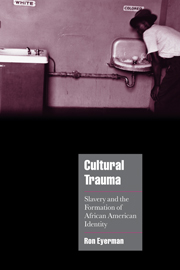Book contents
- Frontmatter
- Contents
- Acknowledgments
- 1 Cultural trauma and collective memory
- 2 Re-membering and forgetting
- 3 Out of Africa: the making of a collective identity
- 4 The Harlem Renaissance and the heritage of slavery
- 5 Memory and representation
- 6 Civil rights and black nationalism: the post-war generation
- Notes
- List of references
- Index
- Cambridge Cultural Social Studies
2 - Re-membering and forgetting
Published online by Cambridge University Press: 22 September 2009
- Frontmatter
- Contents
- Acknowledgments
- 1 Cultural trauma and collective memory
- 2 Re-membering and forgetting
- 3 Out of Africa: the making of a collective identity
- 4 The Harlem Renaissance and the heritage of slavery
- 5 Memory and representation
- 6 Civil rights and black nationalism: the post-war generation
- Notes
- List of references
- Index
- Cambridge Cultural Social Studies
Summary
Memories of slavery disgrace the race, and race perpetuates memories of slavery.
TocquevilleFour million slaves were liberated at the end of the civil war. The exact figure was 3,953,696 (1860) which represents about 12.6 percent of the total American population and 32 percent of the Southern population (these figures also are from 1860, but there was no dramatic change during the civil war). The free black population in the United States in 1860 was 488,070 and in the South 261,918 (Kolchin 1993:241–42). In the first comprehensive historical account written by a black man, George Washington Williams offered this description: “Here were four million human beings without clothing, shelter, homes, and alas! most of them without names. The galling harness of slavery had been cut off of their weary bodies, and like a worn out beast of burden they stood in their tracks scarcely able to go anywhere”(1882:378).
This was written nearly twenty years after the event and is an act of remembrance as much as historical writing. The author was part of a literary mobilization of a new black middle class emerging after the civil war which aimed at countering the image of blacks being put forward by whites, as the “full and complete” integration promised by radical reconstruction gave way to new forms of racial segregation in the South and elsewhere.
- Type
- Chapter
- Information
- Cultural TraumaSlavery and the Formation of African American Identity, pp. 23 - 57Publisher: Cambridge University PressPrint publication year: 2001



